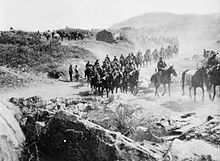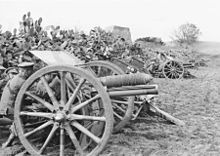Desert Mounted Corps
1917 Battle of BeershebaBattle of Tel el KhuweilfeBattle of Hareira and SheriaCharge at SheriaBattle of Mughar RidgeBattle of Ayun KaraBattle of Jerusalem 1918 Capture of JerichoJordan ValleyFirst Transjordan attack on AmmanSecond Transjordan attack on Shunet Nimrin and Es Salt After reformation The Desert Mounted Corps was an army corps of the British Army during the First World War, of three mounted divisions renamed in August 1917 by General Edmund Allenby, from Desert Column.
As a result of the German spring offensive on the Western Front the corps went through a reorganisation, when the majority of the British yeomanry regiments were dismounted and sent as infantry reinforcements to France.
[11] Chauvel outlined the reasons on 3 September 1920: "The name of the original Desert Column was preserved as far as possible in the title of the new Cavalry Corps, as most of the troops composing it had fought throughout the Sinai Campaign, and by them much had already been accomplished.
[19] The corps now comprised four divisions but had lost its mounted reserve force, and there was no increase in the ten horse artillery batteries, it did however gain its own infantry sub unit, the 20th Indian Brigade.
[30][31][32] The first operation planned for the Desert Mounted Corps was to break through the Turkish lines, in southern Palestine, which stretched for thirty miles (48 km) from Beersheba in the east to the Mediterranean coast at Gaza in the west.
[36][37] Every two weeks the forward division would move en masse towards Beersheba; leaving in the afternoon they marched all night to be in a position on the high ground in front of town by dawn the next day.
At 10:00 the Australian Division reached their start point the Khashim Zanna hill overlooking Beersheba, sending patrols forward to reconnoitre a way into the town.
[44] The 2nd and 3rd Light Horse Regiments unable to approach their objectives under cover, charged in the open through artillery and machine-gun fire, until they reached a depression in the ground 1,500 yards (1,400 m) short of their target where they were able to dismount and fight forward on foot.
[46][e] Grant rallied his brigade, left a small guard force behind and charged into Beersheba and by 18:00 had secured the town, capturing 1,200 prisoners and fourteen artillery guns.
[56] On 7 November the AUS MTD DIV was fighting dismounted in support of the 60th (2/2nd London) Division and darkness had fallen before they could mount up and pursue the retreating Turks.
The ANZ MTD DIV had better luck and had found a hole in the Turkish front and had advance to the train station at Umm el Ameidat on the Junction Station-Beersheba rail line, capturing 400 prisoners and a large quantity of ammunition and stores.
[60] The AUS MTD DIV and 60th Divisions were also successful and fought several small battles during which they captured a number of heavy howitzers by the simple tactic of going round and charging the position from the rear.
At 15:00 the 60th Division came under heavy artillery fire from the area of Huj and requested help from some passing squadrons of the Warwickshire Yeomanry and Queen's Own Worcestershire Hussars, part of the 5th MTD Brigade.
The yeomanry squadrons came out of the dead ground, charged the position from the flank and had almost reached it before the Turks managed to turn their guns around and opened fire at point blank range.
[67] Also on 8 November the YEO MTD DIV had moved to the British left, to attack the Turkish right which would force them across the front of the 53rd Division and the Camel Corps Brigade at Tel KhuweiKeh.
[68] The attempt to cut off the Gaza garrison had failed, their strong rearguard resistance and the scarcity of water had both played a part in stopping the corps from fulfilling their objective.
The 1st LH Brigade reached El Mejdel at noon, defeating the Turkish defenders in a brief fight taking 170 prisoners and capturing the water supply intact.
The YEO MTD DIV arrived some hours later, so by mid-afternoon 10 November the corps less the New Zealand Brigade was in a line from Arak el Menshiy to the coast.
The delay allowed the Turkish forces to consolidate and by 10 November they were constructing a new defence line from Tel el Murre on the coast, along the high ground on the right bank of the Nahr Sukereir river, through Burka to Kustine.
[85] The 75th Division had also secured their objective and held out against a Turkish night time counter-attack and on the right the AUS MTD DIV captured Tel el Turmus virtually unopposed.
[88] The advance continued and on 15 November the ANZ MTD DIV captured Ramleh and 350 prisoners with no opposition, followed the next day by the New Zealand Brigade entering Jaffa.
By now the Turkish forces were entrenched along the north bank of the Nahr el Auja River and the ANZ MTD DIV was ordered to halt, while the army concentrated on capturing Jerusalem.
[90] On 17 November the YEO MTD DIV pursuing the retreating Turkish forces through the hills in front of Jerusalem, came upon a strong rearguard position, on the ridge line between the villages of Sidun and Abu Shusheh.
Discovering that the Turks had broken through a gap in the yeomanry defences and cut their supply route, the infantry successfully attacked and drove them back but were unable to dislodge a larger force located at Saffa.
Struggling against the weather the 2nd Brigade travelled all night and reached Ain el Hekr by 04:30, only having covered sixteen miles (26 km) in twenty-fours hours.
During the rest period a patrol from the 2nd LH Brigade attacked a Turkish position capturing 170 prisoners while another destroyed thirty German trucks and a car that were stuck in mud.
[112] The ANZ MTD DIV resumed the raid early on 27 March, with an infantry brigade and two mountain artillery batteries moving in support from Es Salt.
The British were now being attacked at Es Salt and at Amman, with no reserves available Major-General John Shea of 60th Division but in overall command of the raiding force decided to call off the operation.
That night the ANZ MTD DIV, Camel Corps Brigade and attached infantry pulled back reaching Ain el Sira the next evening.
[129] Elsewhere at dawn the 5th MTD Brigade had left Es Salt for El Howeij arriving at 13:00 but were unable to dislodge the large Turkish force guarding the road bridge into the town.













